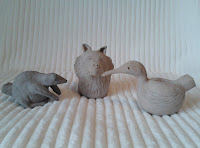
Still on the kitchen theme, I thought we'd create a maple syrup pitcher with the slab and coil method combined. You will need to slice off about a 1 1/2 inch slab of clay from your block.Wedge your clay and flatten it out on your board. Roll it out lengthwise to make a long slab. Use your sticks on the long sides to force the clay to spread out lengthwise to about 1/4 inch thickness. Turn the slab over in the process.On one end of your slab, cut out a cookie base about 2 1/2 inch-3 inches in diameter.Make sure your remaining slab is long enough to stand up and sit around the top rim of your base. Make sure you score the top edge of the base and the edge of your slab, brush slurry on both parts and firmly press the slab onto the base to create a cylinder (third picture on the right). Cut off any excess from the slab so it leaves a neat seam, not overlapping.Add some slurry, press the seam together, and smooth it out with your finger. Smooth the seam at the base as well. If you are out of clay, slice off another 1 inch slab for the coils. If you have leftover clay, wedge it and squeeze some into a 1/2 inch coil. Place both your hands over the coil and roll the clay as you move your hands away from each other, trying to keep the same pressure and movement on each hand. Keep rolling the coil as it gets thinner, and move your hands to the thicker areas trying to make the whole coil uniform.

 Make sure you score and slurry each coil as you attach it. Place the coils on the inside top edge of the cylinder, so the neck curves in like a bottle. Press firmly on each added coil and then smooth out the coil bumps on the outside with your finger or a sculpting tool. A rib tool works well to smooth away any finger marks.You can see in the photo on the right that the coils are curving in to make a bottle neck. Keep a few fingers inside for support as you blend in the coil bumps on the outside. After you have smoothed out the outside.coil bumps, use a sponge that is just barely damp to smooth any uneven areas. Attach a top rim coil to the outside edge of the coil below, press it firmly in place and blend in both the outside and inside coil bumps. This top coil should flare out (photo below right). If you have enough clay left, form it into a 2-3 inch ball for pulling out a handle.
Make sure you score and slurry each coil as you attach it. Place the coils on the inside top edge of the cylinder, so the neck curves in like a bottle. Press firmly on each added coil and then smooth out the coil bumps on the outside with your finger or a sculpting tool. A rib tool works well to smooth away any finger marks.You can see in the photo on the right that the coils are curving in to make a bottle neck. Keep a few fingers inside for support as you blend in the coil bumps on the outside. After you have smoothed out the outside.coil bumps, use a sponge that is just barely damp to smooth any uneven areas. Attach a top rim coil to the outside edge of the coil below, press it firmly in place and blend in both the outside and inside coil bumps. This top coil should flare out (photo below right). If you have enough clay left, form it into a 2-3 inch ball for pulling out a handle.

Pour about 3 inches of water into a bowl, yogurt, or ice-cream container to work over. Shape your ball into an oblong shape and wet the long end. Hold on to the dry end with your other hand. Wet the long end well, and pull the clay out toward you, adding water so it slides easily as you pull. It will form into a handle shape that you can then cut off and attach to your little jug. (photos left and below).


I had an indent on one side of my pitcher, so I took some leftover clay and rolled it out quite thin, cut out a maple leaf shape, scored and slurried the back, and the pitcher, and attached it to cover the flaw. Clay is very forgiving, and many blips can be altered or hidden. My final piece is on the right, however, I probably will do more sponging before it completely dries.








































